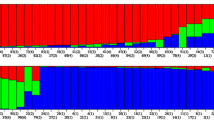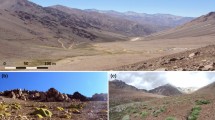Abstract
Caesalpinia echinata, commonly known as Pau-brasil (Brazilwood), the famous tree that named Brazil is native to the Atlantic forest. Men extensively exploited it ever since discovery and colonial times due to its value as a source of red dye. As a consequence, Brazilwood is a threatened species with populations reduced to small forest fragments. Ten polymorphic microsatellite loci were developed from an enriched genomic library. Using fluorescently-labeled primers, a total of 83 alleles were found after analyzing a sample of 44 trees. These high genetic information content markers should allow detailed investigations of mating systems, gene flow, population structure and paternity in natural populations.
Similar content being viewed by others
References
Amorin AM, Fiaschi P, Jardim JG, Thomas WW, Clifton BC, Carvalho AMV (2005) The vascular plants of a forest fragment in southern Bahia, Brazil. SIDA 21(3):1727–1752
Brondani RPV, Brondani C, Tarchini R, Grattapaglia D (1998) Development, characterization and mapping of microsatellite markers in Eucalyptus grandis and E. urophylla. Theor Appl Genet 97:816–827
Bueno E (2002) Nova viagem à terra do pau-brasil. In: Bueno E (ed) Pau-brasil, Axis Mundi, São Paulo, pp 19–38
Cardoso MA, Provan J, Powell W, Ferreira PCG, de Oliveira DE (1998) High genetic differentiation among remnant populations of the endangered Caesalpinia echinata Lam. (Leguminosae Caesalpinioideae). Mol Ecol 7:601–608
Ferreira ME, Grattapaglia D (1998) Introdução ao uso de marcadores moleculares em análise genética, 3rd. Embrapa-Cenargen, Brasília 220 p
Lewis PO, Zaykin D (2000) Genetic data analysis: computer program for the analysis of allelic data. http:// alleyn.eeb.uconn.edu/gda. Cited 20 Sept 2006
Lima HC, Lewis GP, Bueno E (2002) Pau-brasil: uma biografia. In: Bueno E (ed) Pau-brasil, Axis Mundi, São Paulo, pp 39–76
Lincoln SE, Daly MJ, Lander ES (1991) ‘Primer’ software. Available from E. Lander. Whitehead Institute, Cambridge, MA
Lira CF, Cardoso SRS, Ferreira PCG et al (2003) Long-term population isolation in the endangered tropical tree species Caesalpinia echinata Lam. revealed by chloroplast microsatellites. Mol Ecol 12:3219–3225
Varty N (1998) Caesalpinia echinata. In: IUCN2006. 2006 IUCN red list of threatened species. Available via http://www.iucnredlist.org of subordinate document. Cited on July15th 2006
Weir BS (1996) Genetic data analysis II. Sinauer Associates, Sunderland, MA
Acknowledgements
Research supported by Brazilian National Research council—CNPq, Bahia State Foundation for Research Support—FAPESB, and Biodiversitas Foundation. S.C.O.M and F.B.C. held CNPq fellowships.
Author information
Authors and Affiliations
Corresponding author
Rights and permissions
About this article
Cite this article
Melo, S.C.O., Gaiotto, F.A., Cupertino, F.B. et al. Microsatellite markers for Caesalpinia echinata Lam. (Brazilwood), a tree that named a country. Conserv Genet 8, 1269–1271 (2007). https://doi.org/10.1007/s10592-006-9274-y
Received:
Accepted:
Published:
Issue Date:
DOI: https://doi.org/10.1007/s10592-006-9274-y




